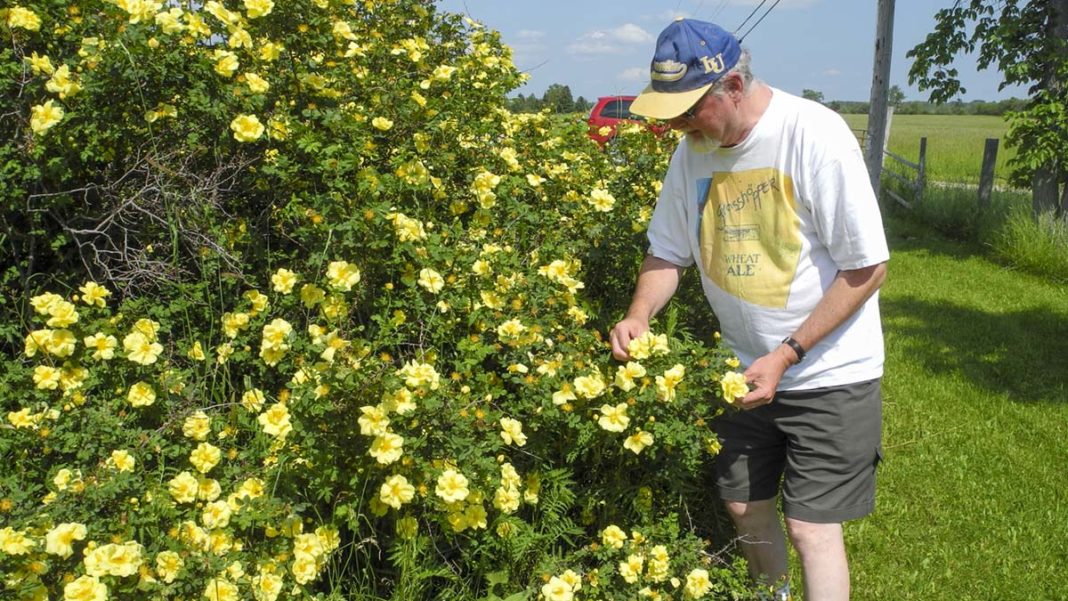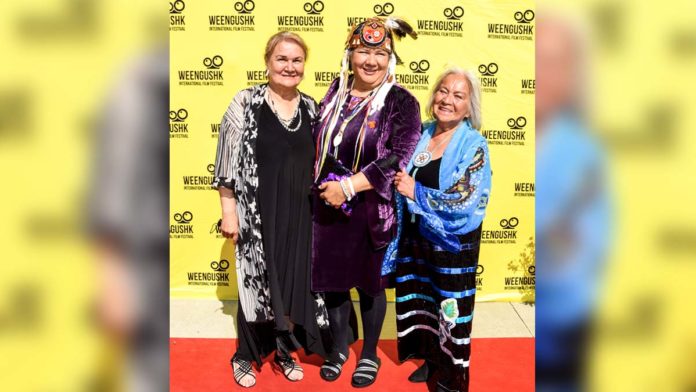by Joe D. Shorthouse
MANITOULIN—What do New York, The Yellow Rose of Texas, The Oregon Trail and Manitoulin Island have in common? A beautiful shrub rose called Harison’s Yellow. This majestic rose shrub with arching canes up to two metres in length and deep golden-yellow blooms has reached legendary status throughout North America and is currently at its best on Manitoulin Island.
Harison’s Yellow is an old hybrid cultivar bred by George F. Harison in a garden in Manhattan, New York in 1824. He developed it by crossing seedlings of Rosa foetida and Rosa spinosssima from Europe. Harison’s Yellow was the first yellow rose to be bred in the United States. Each of its blooms has up to 25 petals compared to wild roses which have five petals.
Being a hybrid means it won’t grow true from seed, but it suckers easily, producing clones of itself. Cuttings taken from mature plants also turn into identical clones.
Cuttings from the New York shrubs were brought to Texas where they did so well, Texans adopted the flower as their own. Best not to tell Texans their rose is not native to Texas, or that the song ‘The Yellow Rose of Texas’ has nothing to do with yellow roses.
If you listen carefully to ‘The Yellow Rose of Texas’ song, you will hear that it is about a woman with yellow skin, and not a rose. The woman in the song is Emily D. West who was half African American and half white. She was born free in Connecticut and was hired in 1835 to work as a housekeeper at a hotel in Texas.
Texas, at that time, was part of Mexico and by circumstance, Ms. West played a pivotal role in the Mexican-Texas war of 1836. Harison’s Yellow was likely growing in Texas when Ms. West arrived. It thrives under harsh conditions and requires little care by gardeners. It is easily propagated by cutting pieces of stems from mature plants and inserting them into the ground. If kept well-watered, roots will appear at the end of the stem and voilà, a new rose shrub is made.
It is this ease of propagation that allowed the women of American pioneers to take it with them as a reminder of home as they walked the Oregon Trail from Independence, Missouri to the Oregon Territory in the mid-1800s. Harison’s Yellow was one of 20 species of roses that were carried along the wagon trail.
Rose cuttings not only survived the arduous 3,200 km journey and were planted at their destination in Oregon, but some of the stems planted along the trail persist to this day.
At some point in the past, shoots of Harison’s Yellow were brought to Manitoulin Island where they found satisfactory growing conditions. Large shrubs occur today at several locations around Manitoulin Island, especially near older buildings.
Healthy examples are found in a private yard in Little Current overlooking the North Channel, near Sheguiandah, and along the Perivale Road West. One rose in Sheguiandah is near a home that has seen four generations, making the shrub at least 75 years old.
Besides being capable of surviving without help from humans, Harison’s Yellow is cold hardy and easily survives temperatures down to -35°C. It is also disease resistant.
The presence of the Harison’s Yellow on Manitoulin Island is remarkable for two reasons. First, after being bred in New York, all its offspring, including those brought to Manitoulin decades ago, came from this one parent plant.
Harison’s Yellow will turn into a large, impenetrable brier clump if the suckers are left to spread. The stems have large prickles (botanists do not call the sharp armaments ‘thorns’) that will cut into your skin and rip your clothing if you press against them.
Being able to survive under harsh conditions in poor soil without any human intervention such as watering and fertilizing—and then rewarding us with weeks of beautiful, fragrant blossoms further illustrates that rose shrubs are amazing ‘creatures’ that deserve our respect.
Secondly, these long-lived shrubs serve as examples of ‘living history.’ We are used to enjoying history by examining books and artifacts in museums, but roses are living proof of breeding events that occurred decades or centuries ago.
The descendants of early pioneers who planted Harison’s Yellow many decades ago have a living connection with their relatives. All the old roses of Manitoulin have a story to tell and if you establish a cutting from one of them in your garden, you become part of ‘planting the pioneer spirit.’
Roses have been of symbolic and cultural importance throughout human history and have been widely used as garden ornamentals, as cut flowers, food (hips used for making jams and teas) medicine (hips are rich in vitamin C), and for the production of essential oils for the perfume and cosmetic industry.
Thousands of rose hybrids have been developed in Europe, Asia, the United States, and the Middle East. Many cold hardy roses have been developed in Canada.
Roses should be included in the gardens of Manitoulin Island because they enhance natural biodiversity and enthrall us with their beauty. Over the years, finding the species or hybrid roses that grow best on Manitoulin Island has been an exercise in trial and error, but thankfully dozens of varieties thrive here.
*Joe Shorthouse is a retired Laurentian University entomology professor and summer resident of Manitoulin Island. He has lectured on the roses and their insects of Manitoulin Island at international rose conferences in Israel and Antibes, France. He is a frequent contributor to The Manitoulin Expositor.





